Steven A. Camarota is director of research, Bryan Griffith is multimedia director, and Karen Zeigler is a demographer at the Center for Immigration Studies.
This analysis merges Census Bureau data with Google Maps API to provide a visual representation of immigration’s (legal and illegal together) impact on public schools at the local level based on the 2,351 Census Bureau-designated Public Use Microdata Areas (PUMAs). Each PUMA very roughly includes seven high schools on average, which allows the most detailed look at the local level with public-use Census Bureau data. We also report statistics by state and metropolitan area. The findings show that, in many areas, immigration has an enormous effect on schools. The share of students from households headed by an immigrant (legal or illegal) is so large in parts of the country that it raises profound questions about assimilation.
What’s more, immigrant households tend to have more students in school on average than households headed by the U.S.-born. A larger share of students from immigrant households also come from low-income families and speak a foreign language at home. This likely creates significant challenges for many schools, often in areas that are already struggling to educate students who come from disadvantaged backgrounds.
Among the findings:
- The 11 million public school students in 2021 from immigrant-headed households (legal and illegal) accounted for nearly one out of four (23 percent) students in public schools. This is double the 11 percent in 1990 and more than triple the 7 percent in 1980.1
- Of students in immigrant households in 2021, 83 percent were born in the United States.
- There are 55 public school students per 100 immigrant households, compared to 33 per hundred in households headed by the U.S.-born. This is partly because immigrants are younger and are more likely to have children and partly because immigrants (91 percent) are more likely to send their children to public schools than the U.S.-born (85 percent).
- In 2021, our best estimate is that 29 percent (3.2 million) of public school students from immigrant households were from households headed by an illegal immigrant. However, this estimate does not reflect the on-going border crisis and huge influx that began in 2021.2
- The impact of immigration on schools tends to be concentrated; just 700 of the nation’s 2,351 Census Bureau-designated PUMAs account for two-thirds (seven million) of students from immigrant households; these same PUMAs account for just over one-third of total public school enrollment.
- The average public school student from an immigrant household lives in an area in which 39 percent of their fellow public school students are also from immigrant households; and one third live in an area in which more than half of students are from immigrant households.
- There are 287 PUMAs where more than half of students are from immigrant households. While these areas of very heavy immigrant settlement are concentrated in few states, there are a number of areas throughout the country where students from immigrant households comprise a very high share of public school students:
- 96 percent in Elmhurst and South Corona, New York City, N.Y.
- 87 percent in Northeast Dade County, North Central Hialeah City, Fla.
- 83 percent in Los Angeles County (Central), Los Angles City, Koreatown, Calif.
- 82 percent in Prince George's County (Northwest), College Park City, and Langley Park, Md.
- 79 percent in Union County (Northeast), Elizabeth City, N.J.
- 78 percent in Houston City (West), Westpark Tollway, West of Beltway TX-8, Texas
- 74 percent in Suffolk County (North), Revere, Chelsea, and Winthrop, Mass.
- 73 percent in Fairfax County (East Central), Annandale, W. Falls Church, Bailey's Crossroads, Va.
- Immigration has added disproportionately to the number of low-income students in public schools. In 2021, 21 percent of public school students from immigrant households lived in poverty and they accounted for 29 percent of all students living below the poverty line.
- Immigrants often settle in areas of high poverty, adding to the challenges for schools in these areas. In the 200 PUMAs with the highest poverty rates in the country, where poverty among students averages 41 percent, nearly 30 percent of students are from immigrant households.
- The lower income of immigrant households likely creates challenges for schools in some areas because tax contributions generally reflect income levels. As a result, immigration can cause a significant increase in enrollment without a corresponding increase in tax revenue.
- Immigration has added significantly to the population of students who speak a foreign language at home. In 2021, 22 percent of public school students spoke a language other than English at home. This compares to 14 percent in 1990 and 9 percent in 1980.3
- On average, public school students who themselves speak a foreign language at home live in a PUMA in which 39 percent of their fellow students also speak a foreign language at home.
- Though one language often predominates in an area, many local schools struggle to deal with a multiplicity of foreign languages, which likely creates significant additional challenges. In 341 PUMAs (total enrollment 7.4 million) 10 or more foreign languages are spoken by public school students.4
- In many of the nation’s largest metropolitan areas (which can include many PUMAs), students from immigrant households account for a very large share of public school enrollment, including:
- 59 percent in San Jose-Sunnyvale-Santa Clara, Calif.
- 56 percent in Miami-Fort Lauderdale-West Palm Beach, Fla.
- 52 percent in Los Angeles-Long Beach-Anaheim, Calif.
- 48 percent in San Francisco-Oakland-Hayward, Calif.
- 47 percent in New York-Newark-Jersey City, N.Y.-N.J.-Pa.
- 42 percent in Houston-The Woodlands-Sugar Land, Texas
- 39 percent in Washington-Arlington-Alexandria, D.C.-Va.-Md.-W.Va.
- 35 percent in Dallas-Fort Worth-Arlington, Texas
- 34 percent in Seattle-Tacoma-Bellevue, Wash.
- 33 percent in Las Vegas-Henderson-Paradise, Nev.
- 30 percent in Boston-Cambridge-Newton, Mass.-N.H.
- States where the share of public school students from immigrant households has increased the most from 1990 to 2021 are:
- Delaware, from 2 to 25 percent
- New Jersey, from 17 to 39 percent
- Nevada, from 11 to 30 percent
- Maryland, from 9 to 29 percent
- Washington state, from 9 to 28 percent
- North Carolina, from 2 to 19 percent
- Virginia, from 6 to 23 percent
- Georgia, from 3 to 19 percent
- Massachusetts, from 13 to 28 percent
- Florida, from 17 to 31 percent
- New York, from 21 to 35 percent
- Texas, from 17 to 31 percent
- Minnesota, from 4 to 18 percent
Introduction
This report uses the 2021 public-use American Community Survey (ACS) and is an update of our 2017 report that used 2015 data. The nation’s 2,351 Census Bureau-designated Public Use Microdata Areas (PUMAs) have roughly 20,000 public school students on average. Examining them allows for a detailed look at the country’s demography at the local level. A PUMA can be thought of as an area that roughly covers seven high schools, though this will vary a good deal from place to place. Nearly one-fourth of public school students in the United States live in household headed by an immigrant, also referred to as a foreign-born person. The foreign-born in ACS data includes all persons who were not U.S. citizens at birth, including naturalized citizens, legal permanent residents, and illegal immigrants. In immigrant-headed households, 83 percent of those attending public school were born in the United States.5 The enormous impact immigration has on public schools, particularly at the local level, and the challenges it creates raises the question: Does it makes sense to continue to admit so many legal immigrants and tolerate widespread illegal immigration without regard to the absorption capacity of our schools?
Findings
A Rapid Increase in Recent Decades. Figure 1 shows the growth in the share of students in public schools from immigrant households over the last 41 years. It also reports the share of students who speak a foreign language at home. The share of students from households headed by a foreign-born person has increased dramatically. While nearly one in four students in public schools were from an immigrant household in 2021, as recently as 1980 it was only one in 14 students. Figure 1 also shows that the number of students who speak a foreign language at home has grown almost as much — driven largely by immigration.
 |
A Highly Concentrated Population. On average, students from immigrant households live in a PUMA in which 39 percent of their fellow public school students are also from immigrant households. One-third of students from immigrant households live in an area in which more than half of students are from immigrant households. There are 287 PUMAs where more than half of students are from immigrant households. These PUMAs account for just 12 percent of all public school students, but 32 percent of students from immigrant households.
State Data. Table 1 shows the share of public school students in immigrant households by state in 1980, 1990, 2000, 2010, and 2021. The growth in many states has been astounding. Between 1980 and 2021 in New Jersey, the share of students in households headed by the foreign-born increased from 11 percent to 39 percent; in Maryland, the increase was 5 percent to 29 percent; in California, it went from 22 percent to 44 percent; and in Nevada, it grew 8 percent to 30 percent. Table 2 shows the top three countries of origin with the most students in each state based on the country of birth of the household head. The table also shows the top three foreign languages spoken at home by public school students. Table 2 reads as follows: Of public school students in California, 44 percent are from immigrant households and of those students, 53 percent live in a household headed by a Mexican immigrant.
 |
 |
Poverty and Language by State. In addition to overall population shares, Table 1 also reports poverty statistics for pupils in immigrant and native households in 2021. In many states, immigration has dramatically added to the number of low-income students. In California and New Jersey, 52 percent of public school students who are in poverty are from immigrant households. In Texas, it is 42 percent and it is 40 percent in New York. Perhaps more surprising is that students from immigrant households account for 42 percent of public school students in poverty in Rhode Island, 37 percent in Massachusetts and Washington State, and 34 percent in Nebraska. Table 1 shows that growth in the percentage of students who speak a foreign language at home roughly tracks the growth in the share of pupils from immigrant households. Looking at the language and poverty data, it is clear that in many states across the country immigration has created very significant challenges for public schools by adding many students with special needs.
Metropolitan Area. Table 3 (download Excel file here) reports the share of students in immigrant households for the nation’s 260 Metropolitan Statistical Areas (MSAs) in 2021 and the top sending countries, again based on the country of birth of the household head. Table 3 also shows the share of students in public schools speaking a foreign language at home by MSA. The impact of immigration varies a great deal across MSAs. In 34 of the nation’s 261 MSAs, more than a third of students are from immigrant households, but in 38 of the nation’s MSAs fewer than 5 percent of students are from immigrant households. Table 3 shows poverty statistics by MSA for immigrant and native households. In nearly half of the nation’s MSAs, poverty for students from immigrant households is at least five percentage points higher than that of natives. This is generally true in all of the areas where there is a large share of students in immigrant households. Generally, MSAs where poverty associated with immigrants is lower are those where immigrant households comprise a small share of the public school student population.
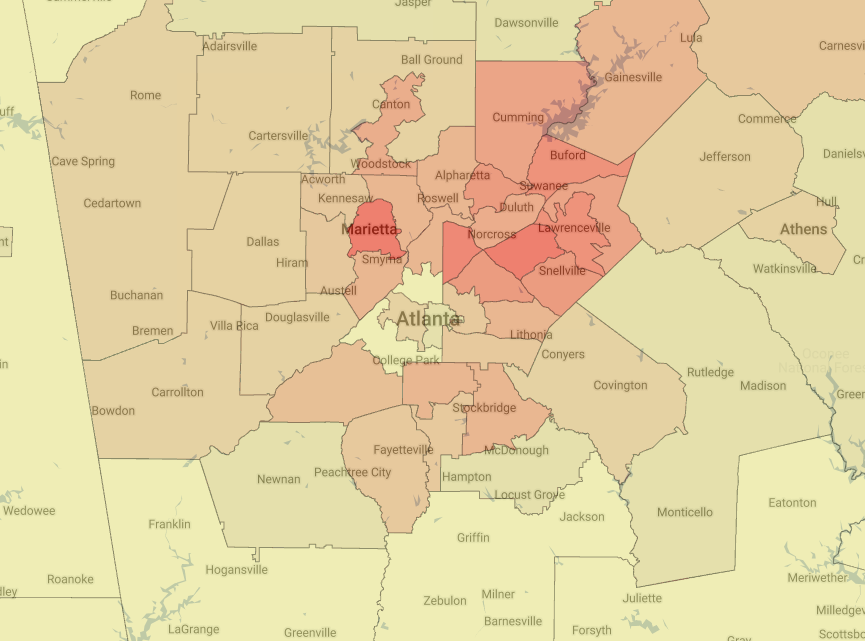
Atlanta
Full Screen
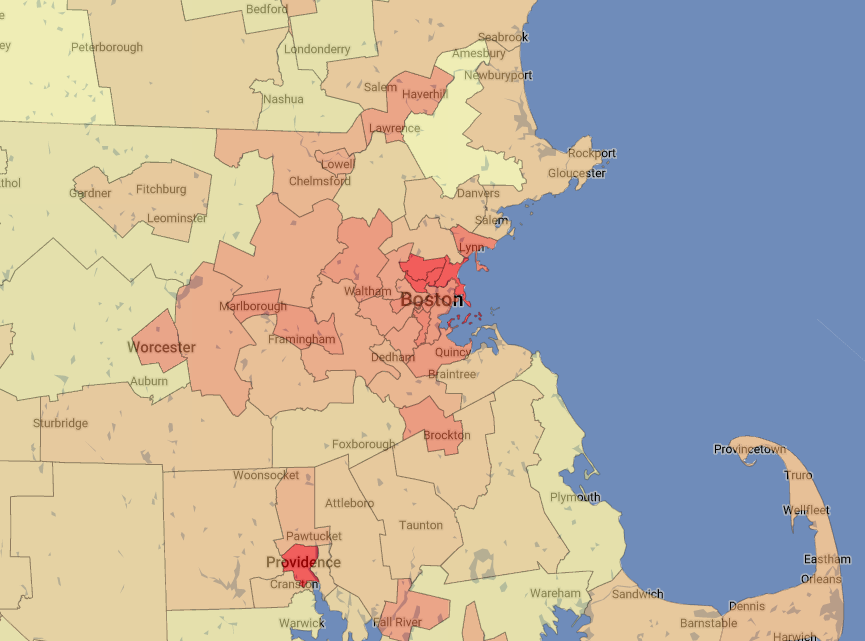
Boston
Full Screen

Chicago
Full Screen
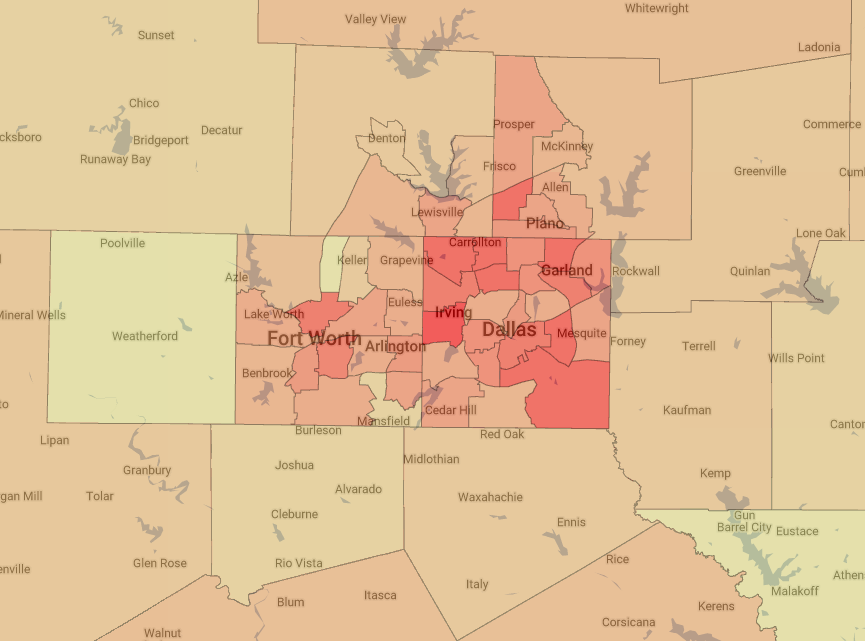
Dallas
Full Screen
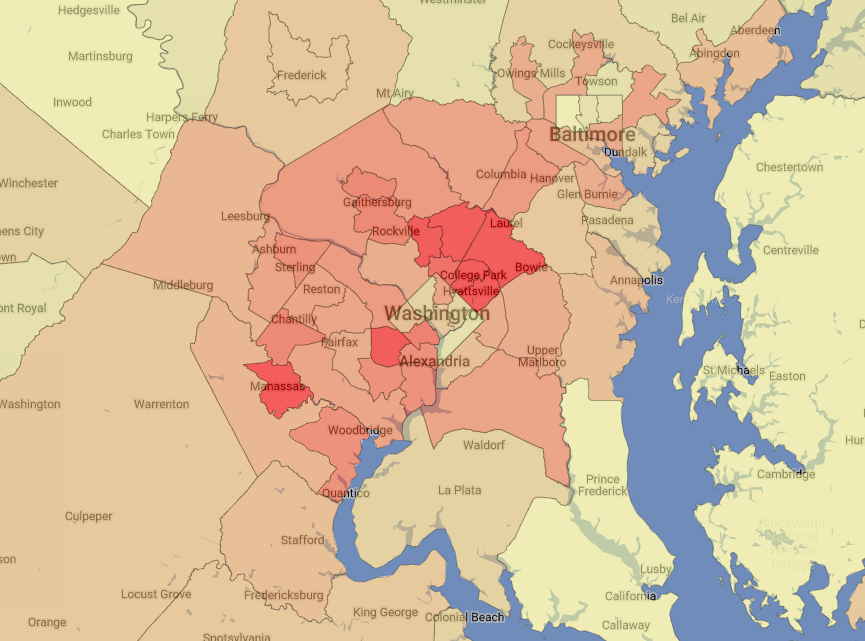
Washington
Full Screen

Houston
Full Screen
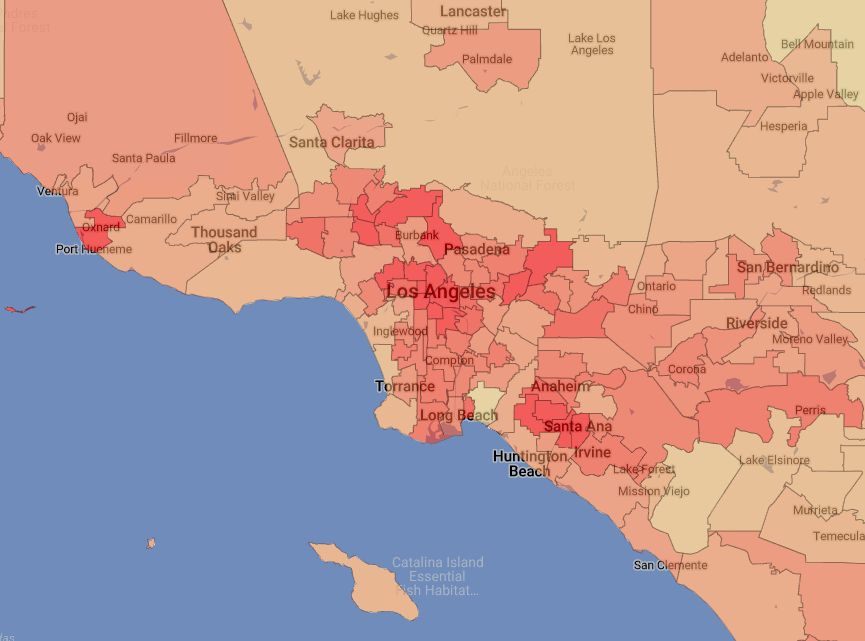
Los Angeles
Full Screen

Las Vegas
Full Screen

Miami
Full Screen

New York
Full Screen

Phoenix
Full Screen

Seattle
Full Screen
Implications for School Budgets. In 2021, there were 55 public school students per 100 immigrant households, compared to 33 public school students per 100 native households. This means that there are 66 percent more public school students in the average immigrant household. This is partly due to immigrants being more likely to have children due to their somewhat younger age profile and higher fertility. Also, the share of students in households headed by the foreign-born who attend public school (91 percent) is higher than the share (85 percent) of students in U.S.-born-headed households. Immigration may tend to strain the budgets of local schools because in addition to having more children in school on average, they are likely paying less in the state and local taxes that provide the vast majority of funding for schools.
The Census Bureau reported that the median income of immigrant households was $66,043 in 2021 — about 8 percent lower than the $71,522 for households headed by the U.S.-born.6 Moreover, the 2021 ACS shows that 67 percent of households headed by the U.S.-born are owner-occupied, compared to 56 percent of households headed by the foreign-born. Homeowners generally pay more on average in property tax, a primary source of education funding, than renters because some of the property tax is absorbed by landlords.7 In Chapter 9 of its very large 2017 study, the National Academies of Sciences, Engineering, and Medicine found that first-generation immigrants create a net fiscal drain at the state and local level when all costs and all revenue is considered in most states. Given the larger size of their households, including more children, and lower incomes, this is not a surprising finding. While immigrants, including illegal immigrants, pay taxes, they almost certainly create significant challenges for schools in some areas by causing a large increase in enrollment without a corresponding increase in local taxes.
Conclusion
The 11 million public school students from immigrant households represent an enormous share of school enrollment in the United States. Clearly, how these children do is vitally important not only to them, but to our country’s future. But their impact raises important questions for immigration policy. First, the fiscal and other challenges immigration creates for schools at the local level should at least be considered by policy-makers when setting immigration policy, including efforts to control illegal immigration. Equally significant, the scale of immigration has important implications for the successful assimilation of immigrants and their children.
As we pointed out in our prior report, one way that assimilation works is that the predominance of the U.S.-born and their children in an area, including local schools, makes the absorption of American culture and identity almost inevitable among immigrants and their children. The map and other data presented here show that the level of immigration, most of it legal, has been so high in recent decades that there are now whole sections of the country where natives and their children are actually the minority or nearly so. Of course, many factors are likely to matter when it comes to the successful integration and assimilation of immigrants. But the relative sizes of the immigrant and U.S.-born populations is certainly important. Probably the most important issue when it comes to immigration is how many people should be allowed into the country. The impact on public schools would seem to be one of the most obvious areas where numbers matter.
Methods and Data Appendix
Data. The data for this Backgrounder comes primarily from the public-use files of the 2021 American Community Survey (ACS).8 The ACS has become one the most important sources of data on the size, growth, and socioeconomic characteristics of the nation’s immigrant population. The public-use files of the 2021 ACS include roughly 3.25 million respondents, nearly 400,000 of whom are immigrants. It is by far the largest survey conducted by the U.S. Census Bureau. The ACS asks individuals if they are enrolled in school and if the school is public or private. The survey also records the grade attended, so it is relatively straightforward to determine public school enrollment. The small number of students who are institutionalized are not included in this analysis. The survey also asks if a language other than English is spoken at home and the particular language spoken. We use the language questions to report foreign languages spoken at home by public school students. The poverty statistics reported here are also taken directly from the ACS public-use files.
Definitions. In this analysis we use the terms “foreign-born” and “immigrant” synonymously. The term “immigrant” has a specific meaning in U.S. immigration law, which is all those inspected and admitted as lawful permanent residents. However, we use the term “immigrant” in the non-technical sense of the word to mean all those who were not U.S. citizens at birth. This includes naturalized American citizens, legal permanent residents (green card holders), illegal aliens, and people on long-term temporary visas such as foreign students or guestworkers, who respond to the ACS. We base the analysis on the share and number of public school students who are from households headed by immigrants. There are, of course, other ways to measure the impact of immigration on public schools, but households are a common unit of analysis used in public policy debates and measuring the impact of immigration in this way is both straightforward and easy for other researchers to replicate.
The Map. The map is based on the nation’s 2,351 Public Use Microdata Areas, as defined by the Census Bureau. The Bureau describes PUMAs as statistical geographic areas designed for the dissemination of data, particularly the ACS. They are contiguous, nested within states, built on county borders, and have 100,000 to 200,000 residents — 141,000 on average. Of these residents, 20,065 are public school students on average. Though the size of high schools varies significantly across the country, PUMAs can be thought of as covering an area that includes five to 10 high schools. Some PUMAs include a number of small counties, but in densely populated parts of the country there are typically many PUMAs within the same large county or city.9 This allows for a detailed look at the local level in the nation’s metropolitan areas. PUMAs are the most detailed level of geographic data available on an annual basis from ACS public-use microdata.10 It should be noted that for the most part PUMAs do not correspond to school districts. However, since public schools draw their students from the area around them, this analysis does provide a look at the impact of immigration on public schools at the local level.
Illegal Immigration. We have not yet developed an illegal immigrant estimate based on the 2021 ACS. However, based on the monthly Current Population Survey, which is another survey collected by the Census Bureau, we have previously estimated that in January 2021 there were 10.22 million illegal immigrants in the country and 11.35 million in January 2022. These estimates imply that there should have been slightly fewer than 11 million immigrants in the country in July 2021, which is the control date for the 2021 ACS. Based on this figure and other information in the ACS, we estimate that 29 percent or 3.2 million public school students from immigrant households in 2021 were from households headed by an illegal immigrant. However, it must be emphasized that this estimate is only preliminary. Moreover, this estimate does not reflect the on-going border crisis, which only began in 2021. Court records and other information indicate that a significant number of school-age illegal immigrants have been released into the country since 2021. By 2023, the number of children from illegal immigrant households must be significantly higher than our 2021 estimate. Moreover, the enormous number of new illegal immigrants now being allowed into the country will have children in the United States who eventually reach school age, thereby significantly increasing the number of children of illegal immigrants in public schools in the future. All of this has significant implications for public school enrollment.
End Notes
1 The historical figures reported in the bullets and in Figure 1 for public school enrollment and language come from the public-use samples of the 1980, 1990, and 2000 Census long form and from the public-use files of the 2010 and 2021 ACS. Tables 1 through 3 also rely on this same data. The 1990 public-use Census data available from the University of Minnesota Ipums website does not include the variable “GRADEATT” or “the grade or level of recent schooling for people who attended regular school or college at the time of the interview”. Other years do include this variable. To create public school data for 1990, we use the age range 5-18, and we use the “EDUCD” variable indicating a respondent’s educational attainment measured by the highest year of school completed. Public school attendance is available in the 1990 Census public-use data. We select those with less than or equal to a high school degree or GED. Comparisons with other censuses show this approach produces estimates that closely match prior years. The estimate for 1990 is then multiplied by 99 percent to produce a 1990 public school estimate.
2 In our prior analysis of public school students based on the 2015 ACS, we estimated that slightly less than one-third of public school students in immigrant households were from households headed by illegal immigrants. This equaled 7.5 percent of all students in public schools. Most research indicates that from 2015 to 2019 the illegal population fell slightly. The Center’s estimate of illegal immigrants based on the January 2021 Current Population Survey is 10.22 million, which is based in part on estimates from DHS for earlier years carried forward. Our CPS-based illegal estimate for 2022 represents a decline of about 1.2 million from DHS’s revised 2015 estimate of 11.4 million. However, at the time of this publication we do not have detailed estimates of the characteristics of illegal immigrants for 2021. It seems likely the number of children from illegal-immigrant-headed households also declined from 2015 to 2021. However, this is not necessarily the case because the longer an illegal immigrant resides in the country the more U.S.-born children will have had time to reach school age, so a smaller illegal immigrant population does not necessarily translate into fewer of their children in public schools. We also know that total enrollment in public schools between 2015 and 2021 actually declined by 1.2 million based on the ACS. Based on the available data, we believe that about 7 percent of all public school students (3.2 million) are from illegal immigrant households and that they account for about 29 percent of all children from immigrant households in 2021.
Due to the ongoing border crisis this number is almost certainly higher now. However, it must be remembered that the big increase in enrollment caused by immigration, including from illegal immigrants, occurs when the U.S.-born children of immigrants reach school age. Since the border crisis began at the start of 2021, none of the children born in the United States to illegal immigrant who arrived in 2021 or later have had time to reach school age. However, a large number of school-age illegal immigrants have been released into the country since 2021 and this has significant and immediate implications for public school enrollment.
3 In 2021, nearly three-fourths of students who spoke a language other than English at home lived in immigrant-headed households.
4 The Census Bureau does not identify all of the languages spoken at home, so the actual number of languages spoken by public school students is higher than that reported here.
5 Of public school students in native-born households, just 0.5 percent are foreign-born; though many more may have one immigrant parent.
6 The Census Bureau used the 2022 Current Population Survey Annual Social and Economic Supplement (CPS ASEC) to calculate this figure. Average income may be a better way of thinking about likely tax contributions than median income. The public-use 2022 CPS ASEC shows that the average income of the two groups is much more similar than the median income. The average household income of immigrant-headed households was only about 3 percent less than the average income of native headed households — $99,809 a year versus $102,771. Still, a quick comparison of average incomes does not support the idea that immigrant households are likely paying significantly more state and local taxes than native households.
In the 2021 ACS, immigrant households had 0.55 public school students on average compared to 0.33 in the average native-born household. Put a different way, it can be said that there are 55 public school students per 100 immigrant households, compared to 33 public school students per 100 native-born households. This means that there were 68 percent more public school students in the average immigrant household than in households headed by the U.S.-born. This is partly due to immigrants being more likely to have children than the U.S.-born, but also because immigrants are much less likely (9 percent) to send their children to private school compared to 15 percent for students in households headed by the U.S.-born.
By itself, the much larger number of public school students in the average immigrant household would not necessarily create a budgetary problem for local schools if immigrants were much more affluent than the U.S.-born and therefore paid a good deal more in taxes on average. But all the evidence indicates immigrant households have lower incomes and it is almost certain they typically pay less in the state and local taxes that provide the vast majority of funding for schools. In Chapter 9 (Table 9-6) of their very large 2017 study, the National Academies of Sciences, Engineering and Medicine found that in the overwhelming majority of states, and all the states with very large immigrant populations, immigrants were a net fiscal drain (taxes paid minus services used) in the first generation. That is, they used more in services, including public education, than they paid in taxes.
Looking at immigrants as they relate to education with newer data indicates that it is very likely that they continue to not pay enough in taxes to state and local governments to cover the costs their children impose on the education system. In 2021 the Census Bureau reported that the median household income of immigrants was $66,043, lower than the $71,522 for households headed by the U.S.-born. The Census Bureau used the 2022 Current Population Survey Annual Social and Economic Supplement (CPS ASEC) to calculate this figure. Average income may be a better way of thinking about likely tax contributions than median income. The public-use 2022 CPS ASEC shows that the average income of the two groups is much more similar than the median. The average household income of immigrant-headed households was only about 3 percent less than the average income of native headed households — $99,809 a year versus $102,771. Still, a quick comparison of average incomes does not support the idea that immigrant households are likely paying significantly more state and local taxes than native households.
It may also be worth pointing out that households headed by the U.S.-born are much more likely to be owner-occupied (67 percent) than immigrant-headed households (56 percent) and it is pretty well established that homeowners tend to pay more in property taxes, a primary source of education funding, than renters. It seems almost certain that immigrant-headed households pay less on average in the kinds of taxes state and local governments use to finance schools than U.S.-born-headed households, even as immigrants create more costs on average for public education.
7 Although homeowners pay more in property taxes, renters also pay property taxes through their rent, as landlords pass the costs of such taxes on to their tenants.
8 See Endnote 1.
9 For more information on PUMAs and how they are created, see the Census Bureau website.
10 It is possible to use public-use data to examine county-level data, but data is available every year only for the largest counties. Census Bureau-designated tracts and blocks, which are smaller than PUMAs, also require five years of pooled ACS data. Further, there is no public-use data from the ACS for these lower levels of geography; instead, researchers are limited to information published for each tract and block by the Census Bureau. As a result, it would be difficult to report some of the statistics in this analysis, which is based on our direct analysis of public-use data from 2021.
